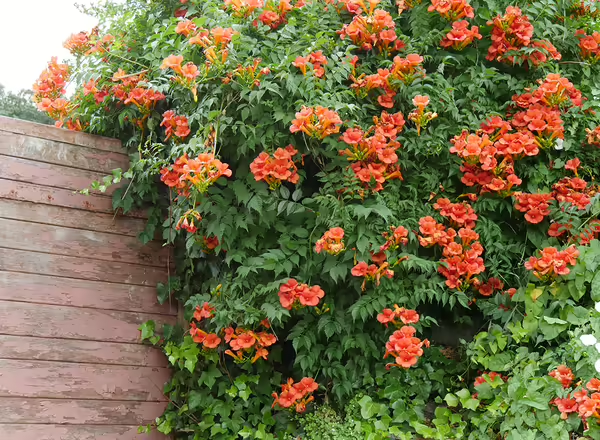
Vines
From small gardens to large public parks, vines add visual appeal and enhance use of both horizontal and vertical spaces.
With a variety of beautiful flowers, striking colors, and interesting leaves, vines draw the eye and can serve as the focal point of a garden. But they also provide excellent ground cover and accent other plants to make a garden feel more full. Vines can enhance the beauty of a building, cover unpleasant features, and increase privacy.
While the strength and versatility of vines are what makes them so special, it can also make them difficult to manage if you haven’t chosen the right vine for your location. Know which vines will thrive in your space and which to avoid for your environment. Understanding how to care for your vines gives you the freedom to enjoy their beauty with minimal fuss and maintenance.
Choosing Your Vines
When it comes to vines, there are a number of choices. There are both perennial and annual vines. Perennial vines are chosen based upon their ability to persist and come back year after year depending on their hardiness to a particular hardiness zone. When selecting these vines, make sure you know what the hardiness zone is for your area and then cross-reference it to the hardiness zone number of the vine. The hardiness zone number for the vine should be at least equal to or smaller than the hardiness zone number for the area you are gardening.
Perennial Vines
There are numerous perennial vines that can add a permanent landscape feature to your garden. When choosing vines listed as perennial, make sure that they are listed as hardy for your planting zone. These vines come back year after year and when properly handled, continue to offer attractive foliage and flowers.
Honeysuckles
As a group, honeysuckles are extremely easy to grow. Many are vigorous plants capable of covering support structures quickly. They offer attractive and offer very fragrant flowers that are visited by butterflies and hummingbirds. When selecting honeysuckles be sure to consult an invasive species list for your area and choose plants that are recommended as non-invasive.
Annual Vines
There are many annual flowering vines to choose from that can offer quick, colorful, temporary cover for garden structures. All of these vines are easy to grow from seed and can be started indoors 4-6 weeks before they are needed for the garden. Because many of them are tender, it is suggested that they be put out after all danger of frost is past and soils are warm. Most annual vines attach themselves by either twinning or with tendrils so chain-link fences, wire, or thin strips of wood make good supports.

Perennial vines offer the ability to add a permanent landscape feature and with proper care, improve in landscape quality over the years. Many of these are woody vines meaning the stems persist year after year and may offer some winter interest of color and/or texture. Others might be herbaceous which means the tops will die back to the ground each year but the roots will overwinter and persist and resume growing next season.
Annual vines are those that are easily grown from seed each year and then transplanted to the garden. They often offer quick cover and in almost all cases the additional feature of attractive and abundant flowering. These will be killed when cold weather or frost arrives.

There are also many tropical vines that are useful in temperate garden settings and can often be overwintered indoors for use the next season. Many vines are multidimensional in regards to what they have to offer and bring to the landscape. When selecting, look for features such as attractive and colorful foliage; showy flowers; interesting or colorful bark or stems; curious plant parts including fruit or seed pods; and fall foliage color.
Vines should also be selected based upon the scale of the plant, size of the garden, and type of support structure. Vines with large, dense, coarse foliage may be more appropriate for large space gardens on a substantial structure and not for an intimate, small space urban garden. While on the other hand a fine-textured vine could be used to add pattern and interest to a bare stone or brick wall.
Vines can also be selected that can attract butterflies and hummingbirds to the garden.
Invasive vs. Aggressive
Some vines are considered invasive meaning they can readily spread into natural areas disrupt ecosystems. Every effort has been made to remove invasive vines in Illinois from the list of suggested vines for a home garden.
It is always a good idea to check with local natural resource personnel or your Extension Service to find out which vines might be on the list locally.

Also, don’t confuse aggressive with invasive.
Aggressive means the plant can spread fast enough within the garden to cause issues to other garden areas where the plant is not wanted or is intended to be growing.
Vines such as trumpet vine or hops can fall into this category because they sucker freely through the garden allowing them to spread. While they can be “controlled” through the diligent removal of suckers, it will be an ongoing chore.
These vines can be especially troublesome in small gardens. So, when selecting a vine don’t fall in love with it immediately just because it has attractive flowers or foliage. First, find out if it has a tendency to sucker or become too big for your space because, once it has been planted and starts to sucker, it may be too late.
Support Structures
In addition to looking at providing the preferred type of surface for attachment, consider the size of the vine. Large, robust vines like Virginia creeper or Dutchman’s pipe can get very large and very heavy and will need a substantial support. Plan for this at the time you plant the vine so you don’t find yourself picking up a structure that was taken down by the weight of the vine.